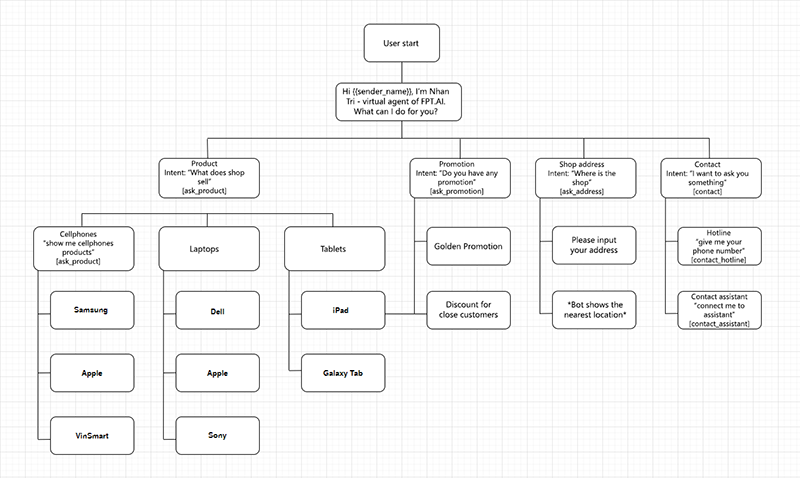Building Chatbot on FPT.AI platform
Bot building process
Bot building is done in 3 steps as follows:
Step 1: Analysis and design
First, the bot designer will need to identify the roles, targets, and channels of the chatbot.
- Target customers
What kind of customers will interact with your bot? They can be internal staff, customers, or a community that cares about one particular issue. For each type have different interests, it is important to identify the target customers to focus on. From here, you will decide what information to teach the Bot, so that it can answer all inquiries from end users.
Correct identification of target customers will have saved time and effort in bot building, allowing focus on solving necessary matters for the customers.
- Interaction channels
Chatbot can interact with customers via various channels like Facebook, Zalo, or Website…
For each channel, there will be corresponding strengths and weaknesses, limits, policies, and terms and conditions. For example, Facebook only allow maximum 3 buttons in one answer. So, if your business utilizes its own conversational applications with separate policies, you will need different ways to connect to bot.
Customers on each channel will also adopt different interaction behaviors and texting manners. Pay close attention to these differences in setting up your chatbot, so as to bring the most exciting and fulfilling user experiences.
If you have only 1 Bot for all channels, make sure that customers on those all have the same interests, and your bot can cater to all their questions.
- Identifying Chatbot topics
After knowing your target users and their behaviors on each channel, you will need to identify topics of interest for these end users.
Conversation history can also be utilized to pinpoint areas where your customers require support.
Example: In finance – banking, customers may care about opening cards, saving packages, consumer loans…
- Creating Chatbot scenarios
In each large topic, users will have multiple interests with various different questions. Therefore, bot builders need to divide one big topic into smaller problems, based on the conversation history. Then, they will need to prepare a set of relevant samples to each of these problem for bot training.
For example, card is a smaller topic of banking, and may include scenarios like: How to open a card, Card functions, Date of Card issuance…
To design your scenarios in the most logical way, describe the smaller ones and divide them into a conversational stream in the form of a tree map.

Step 2: Bot building deployment
- Prepare your data
First, you will need to identify user Intents in each small topic.
For example, in phone information, the user intents can be: Asking for prices, functions, warranty policies…
Next, you will need to list the Samples. These are questions that users will direct at the Bot.
Example:
Intent what_price: how much does the iphone cost, for how much do you sell iphone10, what is the price for iphone at your shop…
Intent what_function: does the iphone10 has fingerprint lock, how many cameras in iphone11…
Intent warranty_policy: how long do warranties last for iphones at your shop, do you offer manufacturer’s warranty or store’s warranty for iphone11, tell me about your warranty policies....
Then, you will need to identify the Entities in your Samples, and tag them.
Example:
Intent what_price: how much does the iphone (tag product) cost, what is your current price for iphone.
Intent what_function: does the iphone10 (tag product) has fingerprint lock, how long does iphone11 (tag product)’s battery last.
Intent warranty_policy: how long do warranties last for iphones (tag product) at your shop, do you offer manufacturer’s warranty or store’s warranty for iphone 11 (tag product).
Bot building on FPT.AI
For detailed instructions on Chatbot building on the FPT.AI platform, please see below.
- Integrating conversational channels
After finishing bot building on one channel, you can easily connect the chatbot to various other messaging platforms like: Facebook Messenger, Zalo, Viber, Website Livechat..., or your own application on webhook.
Step 3: Chatbot update and monitoring
- Content update
Chatbot can automatically answer to thousands of users at a time. Each user, however, adopt different wordings and questions, even though they have the same Intent. Therefore, before launching your customer service chatbot, you have to prepare as many Samples as possible. Also, update, edit, and add Samples frequently via History to further improve your bot’s understanding.
You should pay close attention to Intents regularly used by customers, in order to provide more Samples for those Intents, so that your chatbot can best satisfy customer demands.
- Live Support
We cannot deny that chatbots are growing smarter, however, they still cannot replace human completely. This is why FPT.AI also introduces the Live Support function, where agents can converse and directly support customers should the need arises.
You should have at least one agent readily available to answer customer inquiries regarding specialized topics that the bot cannot handle.
